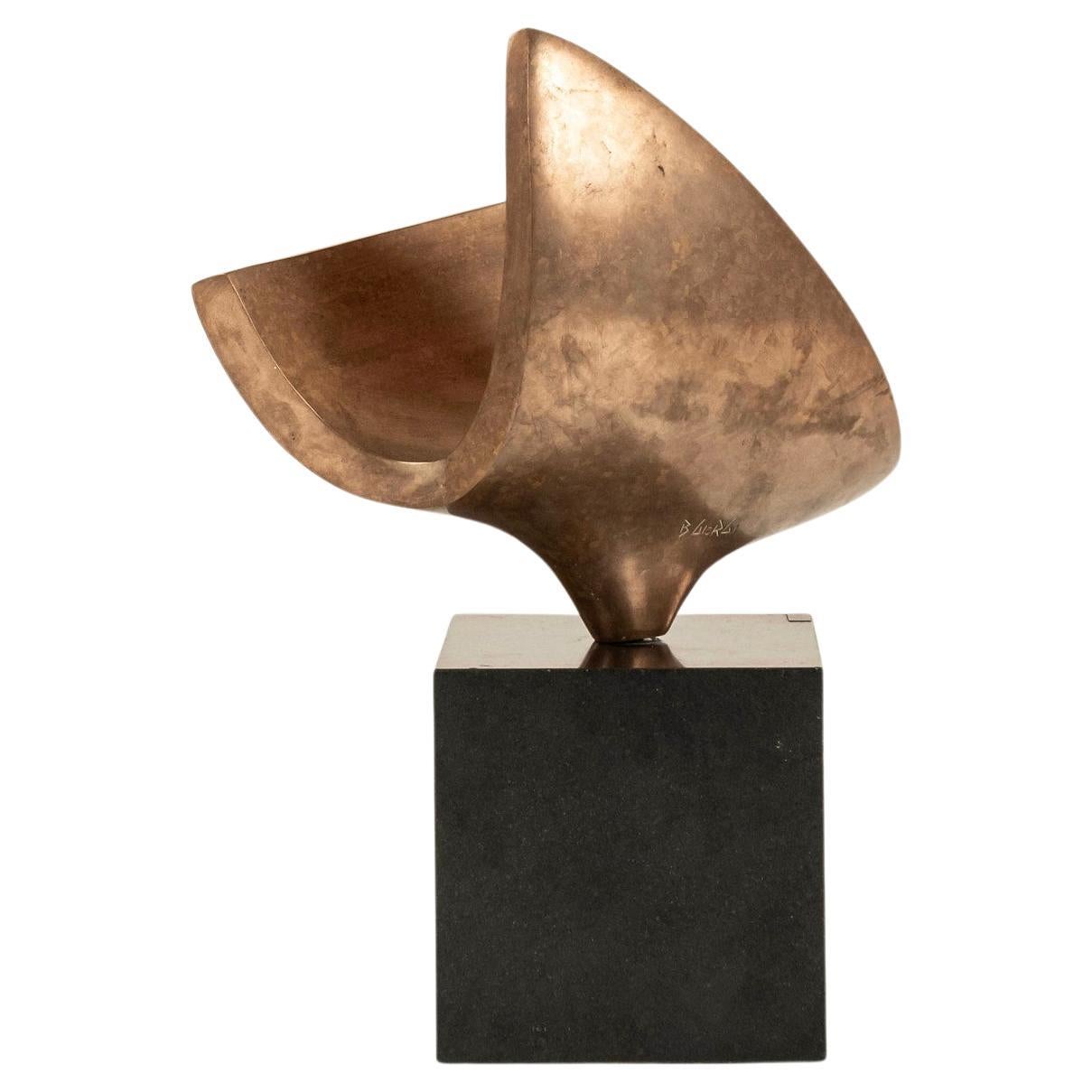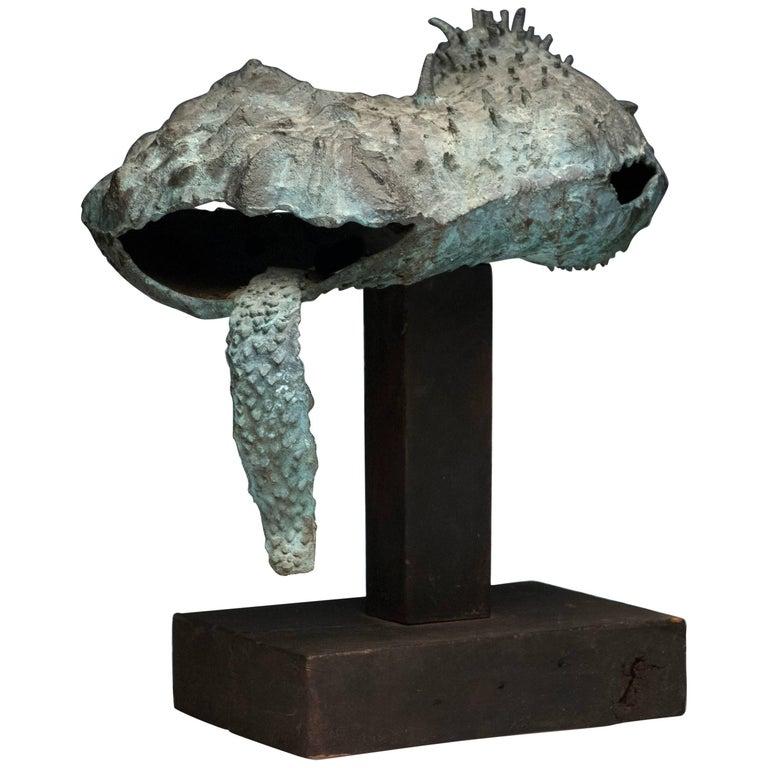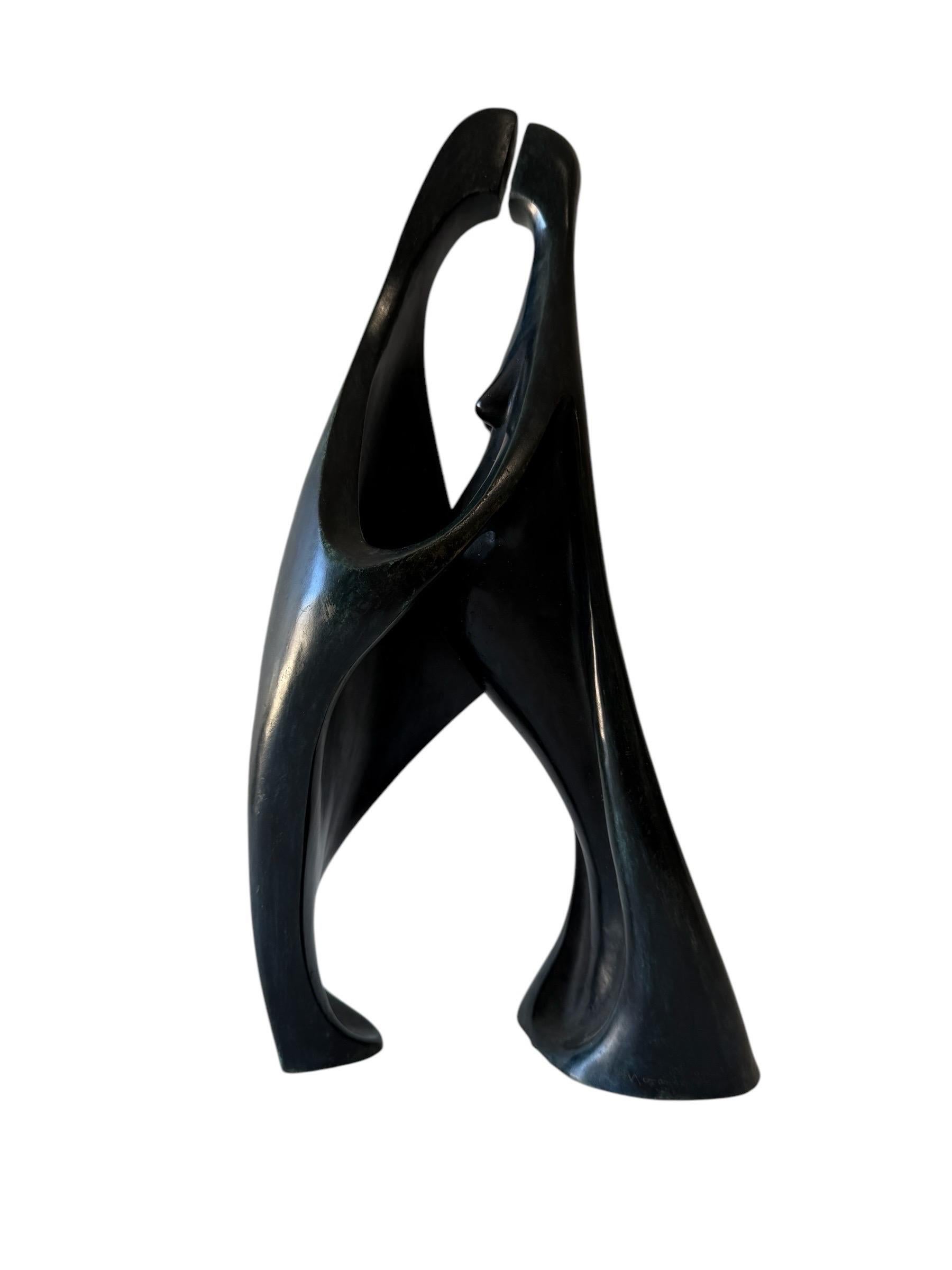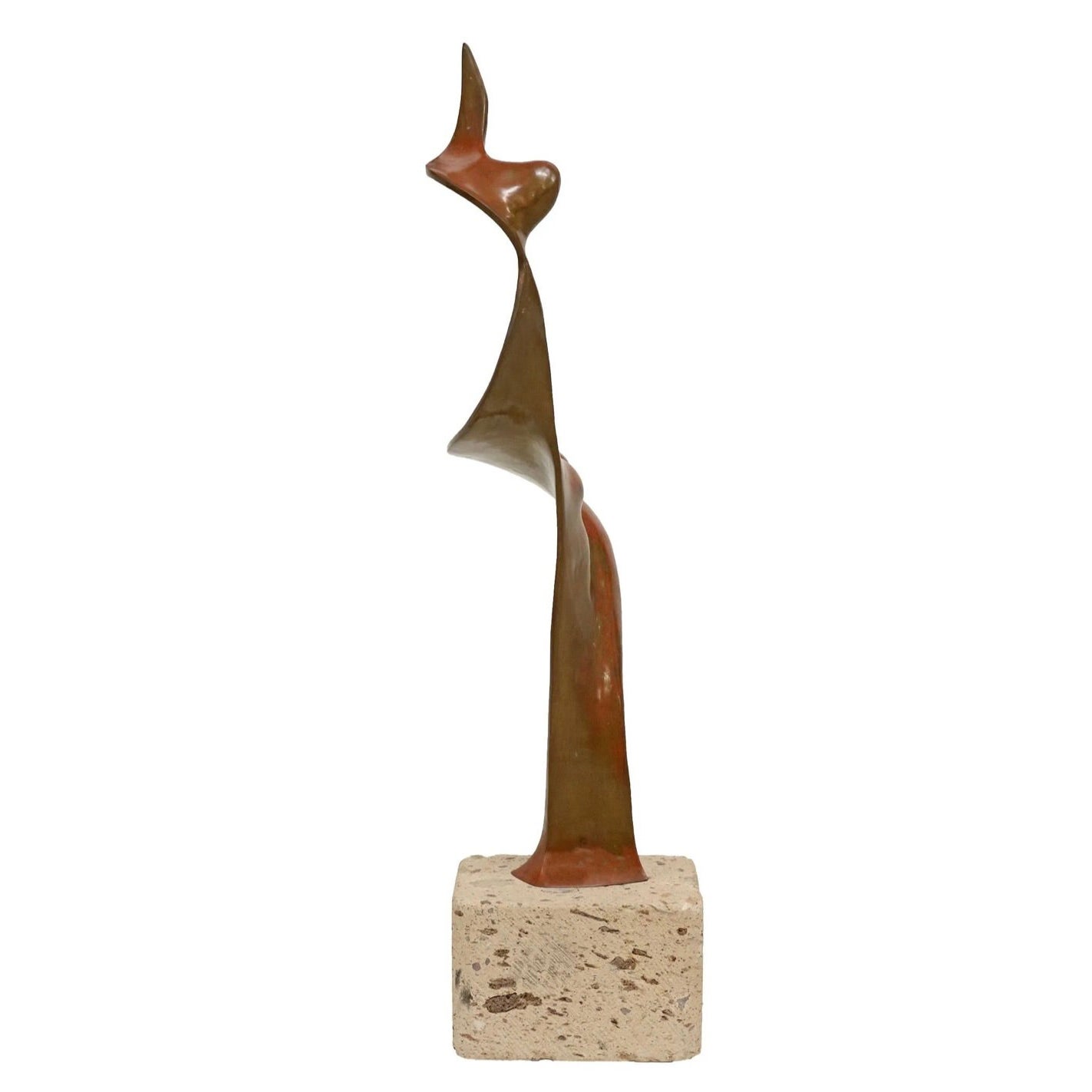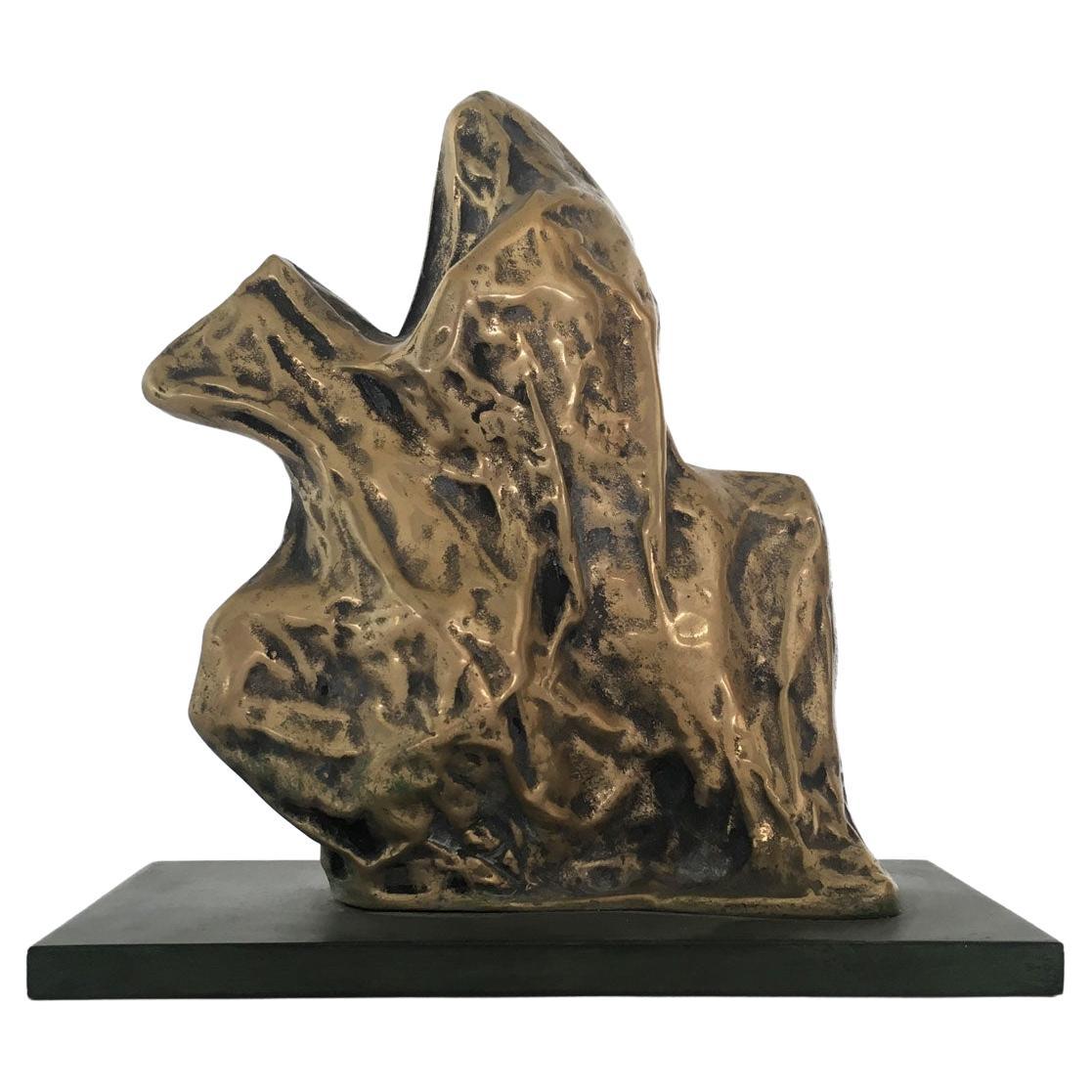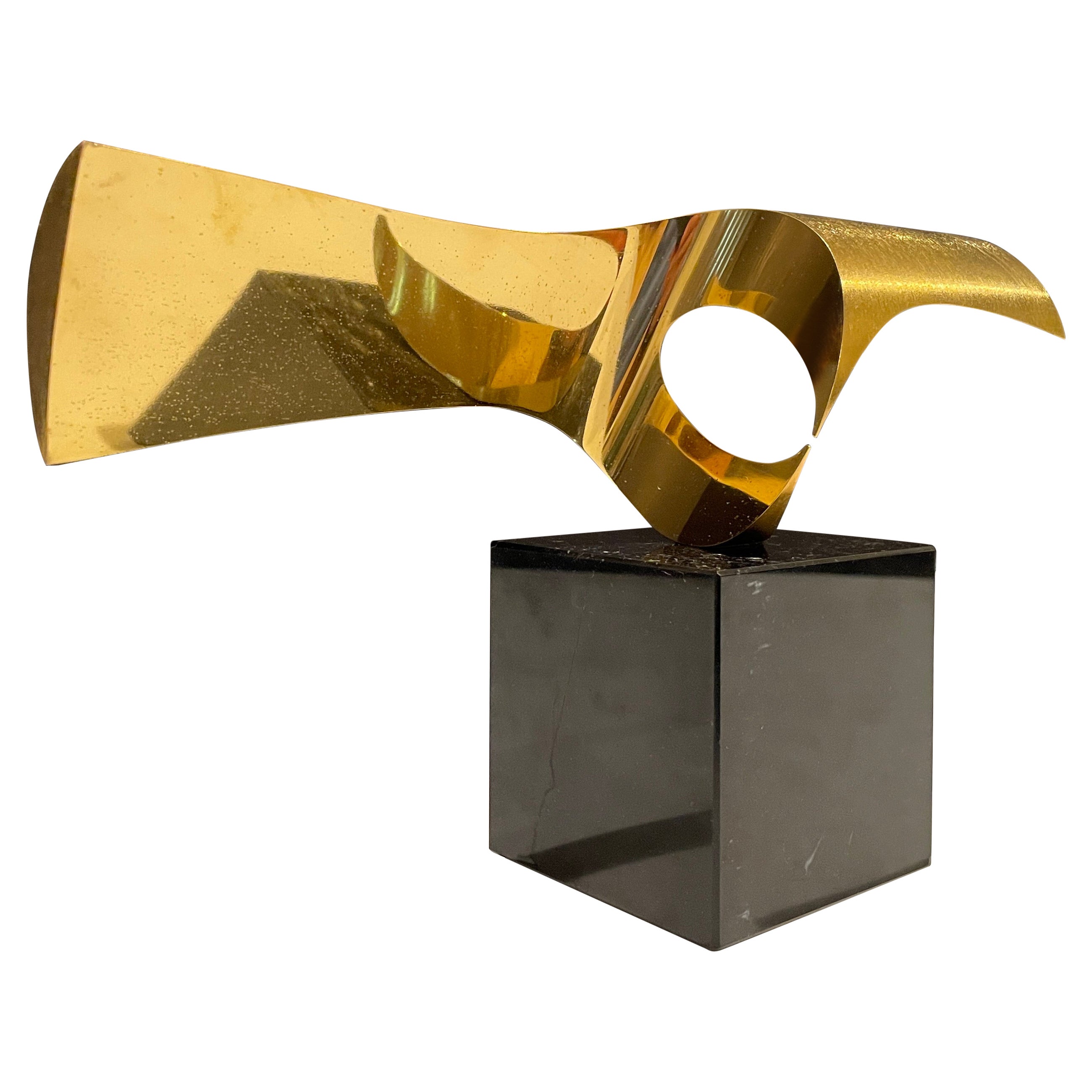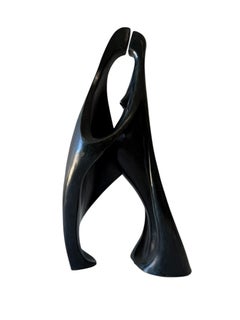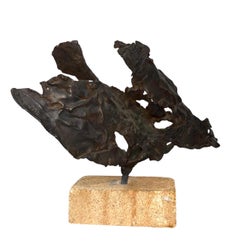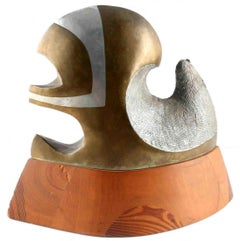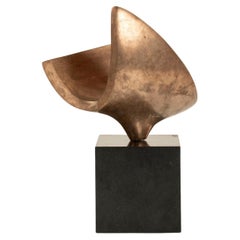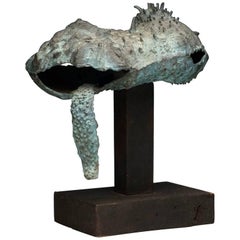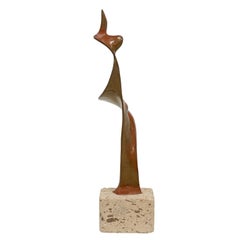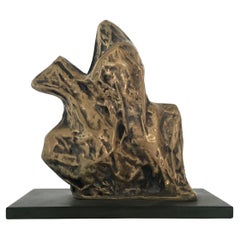Items Similar to Large Latin American Modernist Bronze Abstract Cuban Master Roberto Estopinan
Want more images or videos?
Request additional images or videos from the seller
1 of 20
Roberto EstopiñanLarge Latin American Modernist Bronze Abstract Cuban Master Roberto Estopinan
$6,500
£4,886.28
€5,664.75
CA$9,075.01
A$10,164.49
CHF 5,288.92
MX$123,447.05
NOK 67,050.11
SEK 63,266.78
DKK 42,267.11
Shipping
Retrieving quote...The 1stDibs Promise:
Authenticity Guarantee,
Money-Back Guarantee,
24-Hour Cancellation
About the Item
Roberto Estopinan, Cuban, 1920 - 2015
Dimensions: 24.5" wide x 13" high plus 6" high base.
Roberto Estopiñán (1921–2015) was a Cuban American sculptor known for his sculptures of the human form, including political prisoners. Born in Camaguey, Cuba, he lived in the United States for over fifty years. His works are held by major institutions such as the Museum of Modern Art, the Whitney Museum and the Smithsonian Museum of American Art.
Roberto Gabriel Estopinan, a sculptor, draftsman, and printmaker, was born in Havana, Cuba on March 18, 1921. Estopiñán enrolled at the San Alejandro Academy when he was just 14 years old and became the protegé and studio assistant of the sculptor Juan José Sicre. After graduation he traveled first to Mexico, where he met and befriended Francisco Zuniga, and studied Pre-Columbian sculpture. In 1949 he traveled to Europe, visiting England, France and Italy. In these trips he encountered the sculpture of Henry Moore and Marino Marini, and their humanistic yet formal visions would be influential on Estopinan's work. Estopiñán was a pioneer of direct carvings using wood and of welding techniques in Latin America. Throughout the 1950s, Estopiñán received important prizes at various national exhibitions in Havana. In 1953 he was the only semi-finalist from Latin America at the Tate Gallery's international sculpture competition for a Monument to the Unknown Political Prisoner. In 1961, the artist moved to New York, where he resided until 2002.
Roberto Gabriel Estopiñán a Cuban emigre sculptor who emigrated to exile in the United States not long after Fidel Castro’s revolution in 1959, is considered one of Latin America’s most important 20th-century artists. His work, which includes drawings and prints as well as sculptures in wood and bronze, is in the collections of New York’s Museum of Modern Art, the Smithsonian’s American Art Museum, the Art Institute of Chicago, and the Detroit Institute of Art, among many locations. He is best known for his stark, disturbing renderings of political prisoners, the fruit of his own experiences as a dissident under both Castro and his predecessor, the dictator Fulgencio Batista, and for his representations of the female torso that can remind viewers of both classical statuary and the high-modern, abstractly elongated work of Henry Moore.mHe was born in Havana to a father from Asturias in northwest Spain and a mother of African descent. Estopiñán was something of a prodigy. At the age of fourteen, he won the first prize in drawing at the Centro Asturiano, a regional association for Cubans of Asturian descent. Shortly afterward he received special permission to enter the San Alejandro Academy of Fine Arts in Havana. At the school he was mentored first by its director, the painter Armando Menocal (1863-1941), then by the landscape artist Antonio Rodríguez Morey (1872-1967), and finally by Juan José Sicre (1898-1974), regarded as one of Cuba’s greatest sculptors. Sicre, a professor of sculpture at the Academy, had helped introduce European modernist art to Cuba, and from the 1930s through the 1950s had sculpted monumental figures in Havana of José Martí and other Cuban national heroes that stand to this day. Estopiñán was first Sicre’s student, then his assistant, and, finally, his colleague for the next fifty years. After graduating from San Alejandro in 1942, Estopiñán began simultaneously teaching art at the Ceiba del Agua School for young men, assisting Sicre in public art projects and developing his own artistic vision. He also traveled widely, to Mexico, New York, France, and Italy. From the late 1940s through the 1950s his sculpture evolved from an early neoclassical phase under the influence of Maillol to what he defined as “formalist humanism”: emphasizing the abstract beauty of the shapes he sculpted while not abandoning the human figure as the basis of his work. As the 1950s progressed he chose to carve in native Cuban woods as well as weld scraps of various metals. Although he was obviously influenced by Henry Moore and Julio González (1876-1942), a Spanish modernist sculptor whose iron weldings prefigured Estopiñán’s weldings in bronze, he had already created his own visual language. Estopiñán joined the Directorio Revolucionario Estudiantil, an anticommunist, pro-democracy student-based organization that opposed the Batista regime. Estopiñán recalled: “I wanted to be true to myself, which meant being a modern artist and a believer. Georges Rouault and Ernst Barlach could do it, as well as abstractionists like Alfred Manessier and Jean René Bazaine. But so could artists who were not traditional believers, like Henri Matisse in the chapel at Vence, like Germaine Richier at Assy. I am not talking of grotesqueries like Le Corbusier’s church [an asymmetric concrete chapel with tiny windows erected in 1955 in Ronchamp, France], but something deep and clear and balanced.”
During the 1970s Estopiñán’s style shifted toward a more organic figuration, reflecting his desire to convey a synthesis between the human body and plant life. By the 1980s he had arrived at a new classicism, austere and simplified, in which the female torso whose renderings he became famous for and the political prisoners who continued to haunt him were his most constant themes, right through the end of his life.
In 2002 Estopiñán and his wife, Carmina Benguría, a performance artist and fellow exile, moved from New York to Miami. Since the 1980s, he has been involved with the female torso as his favorite expressive form. As a printmaker and draftsman, his production was thematically parallel to his sculptures. The most complete collection of his prints (1959-96) is found in the Jersey City Museum in New Jersey, where an exhibition was hosted in the spring of 1996. Together with Juan José Sicre, Alfredo Lozano and Agustin Cardenas, He has exhibited with José Bedia, Tomás Sánchez,
Manuel Mendive, Wifredo Lam, Armando Morales and many more masters of Cuban art. Estopiñán is considered one of the pioneers of modern sculpture in Cuba and Latin America. The artist recently retired to Miami, FL.
“His work in the early 1950s was an evocation of Aristide Maillol and his resonant masses. During the same decade, Estopiñán produced totems and angular figures that reverberated with influences from Africa and Oceania.
He was included in the influential 1988 show at Miami Dade College. An exhibition of Twentieth Century Cuban Art from the Collection of Ramón Cernuda and Nercys Ganem. Artists included: Eduardo Abela, Víctor Manuel, Aristides Fernández, Fidelio Ponce, Carlos Enríquez, Amelia Peláez, Mario Carreño, René Portocarrero, Mariano Rodríguez, Cundo Bermúdez, Raúl Millían, Roberto Estopiñan, José Mijares, Agustin Fernández, Angel Acosta León, Gina Pellón and Arturo Rodríguez.
Bibliography, Xenia Bas de Tamayo: Roberto Estopiñán: El escultor que insiste en buscar la forma más pura. Replica, Miami, FL 1992-1993. in Veigas, J., et al, eds. Memoria, Cuban Art of the Twentieth Century. 1st ed. Los Angeles, CA: California International Arts Foundation, 2002.
- Creator:Roberto Estopiñan (1921 - 2015, Cuban)
- Dimensions:Height: 24.5 in (62.23 cm)Width: 19 in (48.26 cm)Depth: 5 in (12.7 cm)
- Medium:
- Movement & Style:
- Period:
- Condition:Please see photos.
- Gallery Location:Surfside, FL
- Reference Number:1stDibs: LU38215945582
About the Seller
4.9
Platinum Seller
Premium sellers with a 4.7+ rating and 24-hour response times
Established in 1995
1stDibs seller since 2014
1,777 sales on 1stDibs
Typical response time: <1 hour
- ShippingRetrieving quote...Shipping from: Surfside, FL
- Return Policy
Authenticity Guarantee
In the unlikely event there’s an issue with an item’s authenticity, contact us within 1 year for a full refund. DetailsMoney-Back Guarantee
If your item is not as described, is damaged in transit, or does not arrive, contact us within 7 days for a full refund. Details24-Hour Cancellation
You have a 24-hour grace period in which to reconsider your purchase, with no questions asked.Vetted Professional Sellers
Our world-class sellers must adhere to strict standards for service and quality, maintaining the integrity of our listings.Price-Match Guarantee
If you find that a seller listed the same item for a lower price elsewhere, we’ll match it.Trusted Global Delivery
Our best-in-class carrier network provides specialized shipping options worldwide, including custom delivery.More From This Seller
View AllLatin American Art Figurative Abstract Bronze Sculpture Lovers Marcelo Morandin
Located in Surfside, FL
Marcelo Morandin 1933-1996
Untitled (Embracing Couple, Lovers)
Bronze 1988; ed. P/E; Hand signed, dated and editioned to lower edge DImensions: 48.5 x 32 x 21 cm / 18.8 x 12.5 x 8.2 inches (approximately)
PAREJA, Bronce, patinado
Marcelo Morandin (1933 - 1996) was active/lived in Argentina, Mexico.
Argentinian, Mexican Postwar & Contemporary sculptor Morandin is best known for his monumental sculpture. This is a wonderful, art deco inspired nude couple, the woman appears pregnant).
Marcello Morandín (Marcelo Román Morandín Paroni) was born in 1933 in Argentina. He was an important plastic artist and Argentine architect, distinguished in Mexico for being an excellent sculptor and furniture designer. At the end of his studies at the Faculty of Architecture of Buenos Aires, Argentina, he traveled to Mexico and settled in Xalapa, Veracruz. In this city he was part of several artistic projects and noted for being one of the founders of the Department of Aesthetic Research and Applied Design at the University of Veracruz, as well as the Department of Aesthetic Research at UNAM. Between the years 80 and 90, he carried out several monumental works, among them "La pigeon de la paz" a project for the UN; "The foundation of Tenochtitlan" located in front of the Official Residence of Los Pinos; and "The Kinetic Tower" Of the government of Veracruz that combines the light and the sound with diverse moving parts to the compass of the music of Arnold Schoenberg. (Lily Kassner. Dictionary of Mexican sculptors of the twentieth century. Volume II. Mexico. Conaculta, 1997). Similar in style to Israeli artists Aharon Bezalel and Isaac Kahn.
He has shown with Jose Villalobos, Nicolas Moreno, Pedro...
Category
1980s Abstract Sculptures
Materials
Bronze
Argentine Modernist Brutalist Abstract Bronze Sculpture Jewish Latin American
By Naum Knop
Located in Surfside, FL
Naum Knop (Ukrainian-Argentinean, 1917-1993) Modernist Brutalist bronze figural sculpture with heavy verdigris green finish. Melted forms in the shape of an abstract pretzel like twist. Affixed to white stone plinth. Artist signature, "NK" side of base. Good condition, shows rich green patina and aged oxidation. Measures approximately 17.5 in. x 19.5 in. x 6.5 in.
Naum Knop, Argentine sculptor, was born in 1917 in Buenos Aires, into a Jewish family of Russian origin from Ukraine. His childhood was spent in the neighborhood of La Paternal where his father had a carpentry workshop, a space in which he made contact for the first time with the technique of wood carving. After finishing elementary school, he worked with the teacher Luis Fernández and soon after he dedicated himself to furniture design. Around 1935, he entered the Manuel Belgrano School of Fine Arts . Between 1941 and 1942 he attended the course for graduates taught by Alberto Lagos and Alfredo Bigatti at the National School of Fine Arts and continued his training between 1942-1945 at the Ernesto de la Cárcova High School with Soto Avedaño, Carlos de la Cárcova and José Fioravanti. At this time he put his works in dialogue with other young artists such as Libero Badii and Aurelio Macchi .
Around 1947 he made his study trip abroad. He goes to California, United States, where he enters the Art Institute of Los Angeles. At the same time visit museums and galleries. In January 1948 he organized his first exhibition abroad, held at the Hall of Arts in Beverly Hills in Los Angeles. During this period he toured Chicago and then New York. That year he traveled to Europe; his itinerary includes France, Italy, Switzerland and England. As a result, he came into contact with the work of Henry Moore, Hans Jean Arp, Jacques Lipchitz, Constantin Brancusi, Umberto Boccioni, Henry Laurens, Ossip Zadkine. Artists who have an impact on the young Knop and whom he honors in his subsequent production. He returned to Argentina in 1949 and installed his workshop where he worked on ornamental carving and on pieces in which he oscillated between a synthetic figuration and abstraction.
In 1956 he began his successful participation in salons , obtaining numerous awards at the national and municipal level. In 1959 he participated in the shipment to the 5th São Paulo Biennial and since then, to the success achieved at the local level, the multiple exhibitions carried out in the international field have been added. The exhibitions in Tel Aviv , Jerusalem and Rome (1966) stand out; Dusseldorf (1977); Los Angeles and Palm Spring (1981); New York (1986), San Pablo and Los Angeles(1989). During this period, his work matured, while he began to experiment with the direct wax technique, obtaining textured surfaces similar to welds that gave it a strong abstract expressionist feature. In parallel to his personal production and to the small models, the artist receives private and public commissions for which he works on large-scale sculptures and murals. Around 1967, the architect Mario R. Álvarez summons him to participate in a closed competition for the creation of a work to be located in the General San Martín Cultural Center . Libero Badii and Enio Iommi participate with the artist ; the bronze Reclining Figure Knop is chosen. Among the large-scale monuments it is worth remembering the piece Los tres soles temporarily located in Recoleta in 1984 and later installed in Maryland, United States; as well as Seated Figure (Reminiscence of Michelangelo) located in the shield of a private building in 1970. To these are added the numerous murals in which he experiments with various materials and techniques such as casting in bronze, openwork and reliefs in wood and work in cement.
He was included in the The 1962 International Prize for Sculpture the jury included Argan, Romero Brest and James Johnson Sweeney the former director of the Solomon R. Guggenheim Museum in New York. The participants included Louise Nevelson and John Chamberlain for the United States; Lygia Clark for Brazil; Pietro Consagra, Lucio Fontana, Nino Franchina, and Gió Pomodoro for Italy; Pablo Serrano for Spain; and Eduardo Paolozzi, William Turnbull, and Kenneth Armitage for England. Gyula Kosice, Noemí Gerstein, Julio Gero, Naum Knop, Aldo Paparella, Enrique Romano, Eduardo Sabelli, and Luis Alberto...
Category
Mid-20th Century Abstract Abstract Sculptures
Materials
Stone, Bronze
Brutalist Israeli Bronze Abstract Sculpture Wave Form Zvi Aldouby
Located in Surfside, FL
Zvi Yehuda Aldouby (1904 - 1996) was active/lived in Israel. Zvi Aldouby is known for Artist, teaching.
Biography photo for Zvi Jehuda Aldouby
Zvi Yehuda Aldouby (Hirsch Leib Zupnick), sculptor, born 1904, Galicia. Immigrated 1924. Upon aliyah in 1924 he worked in agriculture and construction. 1936-51 studied art and the history of art with Trude Haim, Professor J. Schwartzman, Ds. Schiff, Pinkerfeld, Aviyona, Javetz, and others.
After WWII he worked for the Jewish Agency as an envoy in Italy under the aegis of the UNWRA, on the welfare of the survivors of the Holocaust in the DP Camps. In 1948 in Paris, he evaluated advanced studies in European Art Centers. He was a member of the Israel Painters and Sculptors Association. He was a member of the Artists' Village in Ein Harod from its inception. EIN HAROD About the Museum's Holdings: Israeli art is represented by the works of Reuven Rubin, Zaritzky, Nahum Gutman, Mordecai Ardon, Aharon Kahana, Arie Lubin, Yehiel Shemi, Yosl Bergner and others.
The graphic arts collection contains drawings and graphic works by Camille Pissarro, Modigliani, Jules Pascin, Marc Chagall (almost all of his graphic work), and numerous other artists. The sculpture collection includes works by Jewish sculptors from all over the world including leading Israeli sculptors; Ben Zvi, Lishansky, David Palombo (brutalist), Yehiel Shemi, Aharon Bezalel and Igael Tumarkin (surrealist). Many Jewish sculptors from all parts of the world, beginning with Mark Antokolsky, are represented in the collection. In the sculpture courtyard there are works by Chana Orloff, Jacob Epstein (the works he bequeathed to the Museum), Enrico Glicenstein, Loutchansky, Constant and Indenbaum from Western Europe; Glid from Yugoslavia; William Zorach, Chaim Gross and Minna Harkavy from the United States; and most of the outstanding sculptors of Israel : Zev Ben-Zvi, Lishansky, Ziffer, Rudi Lehmann, Dov Feigin, Moshe Sternschuss, Zvi Aldouby, Yehiel Shemi, Aharon Bezalel, Hava Mehutan, Igael Tumarkin.
Education:
1924-28 Hebrew University, Jerusalem, graduated
1931-37 Teachers' Seminar, Jerusalem, Teacher's Certificate
1938-29 Advanced studies, with Trude Haim
Joseph Schwarzman, School of Art
1948-50 Advanced studies in Italy and France
Teaching
Taught history of art and sculpture Holon
Awards And Prizes
1957 Herman Struck Prize, Artists' Association of Haifa and the North, Haifa Municipality
1963 Dizengoff Prize for Painting and Sculpture, Municipality of Tel Aviv-Jaffa
1964 Medal from Monaco International Exhibition
1965 Prize for the ''Breakthrough into the Negev'' proposal for a monument, Givati Corps, 52nd Brigade
1967 The Histadrut Executive Prize
1991 Worthy Citizen of Tel Aviv Award, Municipality of Tel Aviv-Jaffa
Environmental Sculptures
1961 Levant Fair, Tel Aviv, "A Sculpture in a Garden"
1968 Atlit Youth Club, Bas- Relief- "Davd Playing Before King Saul"
1969 Netivot (Negev), "Yizkor"- Monument memorializing Aliyat Hanoar youngsters from Tunisia who perished in an air crash.
1944 Collective Annual Exhibition by Palestinian Artists
Art Gallery of the ''Habima'' Building, Tel Aviv
Artists: Hermann Struck, Moshe Sternschuss, Arie Reznik, Aaron Priver, Yitzhak Itzhak Danziger, Zvi Aldouby, Menachem Shemi, Moshe Castel, Shmuel Ovadyahu, Yohanan Simon, Marcel Janco.
Group Exhibition - Etched Voices, Yad Vashem, Jerusalem painting...
Category
1950s Abstract Sculptures
Materials
Limestone, Bronze
Chester Williams, Black Artist, Abstract Bronze, Wood African American Sculpture
Located in Surfside, FL
Chester L. Williams
Label on bottom, signed. Title: Promethium
Medium: Bronze, Aluminum and wood.
Approx. dimensions: 12 X 11 X 4 inches.
Chester Lee Williams (1944-1919) was born in 1944, in Durham, North Carolina. Chester cultivated a creative mind that eventually led him to pursue an education in fine arts and sculpture at North Carolina Central University (BA) and the University of Michigan (MFA). In 1974, he made his way to Tallahassee and started instructing at FAMU. Students at the university have a deep appreciation for the jazz lover’s insight and skill. A lifelong artist, Chester's work has been featured in galleries and publications across the country. The body of his work produced over 45 years has evolved from smooth and supple sculptures into the more angular and defiant shapes seen in his later works. Chester has said: "All of the works are me. I still embrace every one of them." Chester enjoyed traveling and exploring different cultures. His art was influenced by his travel and knowledge of African culture. He was an educator for 37 years, teaching at Voorhees College, North Carolina Central University and Florida A&M University before retiring in 2011.
He sold his first piece of art in the ninth grade to his homeroom teacher. (That early sale paid off — years later, that teacher’s husband, the president of a bank, commissioned Williams to create a sculpture for the bank’s lobby...
Category
20th Century Abstract Abstract Sculptures
Materials
Metal, Bronze
Mid Century Modern Brutalist Welded Abstract Expressionist Sculpture
Located in Surfside, FL
Neo-Dada Abstract Sculpture: Assemblages
In contrast, abstract sculpture followed a slightly different course. Rather than focusing on non-figurative subject matter, it concentrated...
Category
Mid-20th Century Abstract Expressionist Abstract Sculptures
Materials
Metal
Brutalist Bronze Abstract Modernist Sculpture
Located in Surfside, FL
In the manner of Julio Gonzalez, mixed metal sculpture.
Neo-Dada Abstract Sculpture: Assemblages
Abstract sculpture followed a slightly different course. Rather than focusing on non-figurative subject matter, it concentrated on materials, hence the emergence of Assemblage Art - a form of three-dimensional visual art made from everyday objects, said to be 'found' by the artist (objets trouves). Popular in the 1950s and 1960s in America, assemblage effectively bridged the gap between collage and sculpture, while its use of non-art materials - a feature of Neo-Dada art - anticipated the use of mass-produced objects in Pop-Art. Assemblage sculpture is exemplified by the works of Louise Nevelson (1899-1988), such as Mirror Image 1 (1969, Museum of Fine Arts, Houston), and by Jean Dubuffet (1901-85) and his Monument with Standing Beast (1960, James R. Thompson Center, Chicago). The idiom was considerably boosted by an important exhibition - "The Art of Assemblage" - at the Museum of Modern Art, in New York, in 1961.
Other examples of the Neo-Dadaist-style "junk art...
Category
20th Century Abstract Expressionist Abstract Sculptures
Materials
Bronze, Copper
You May Also Like
Bruno Giorgi Bronze Sculpture
By Bruno Giorgi 1
Located in Houston, TX
20th Century bronze sculpture created and signed by the artist Bruno Giorgi (1905-1993). Sculpture is detachable from granite base.
Category
Mid-20th Century Brazilian Organic Modern Abstract Sculptures
Materials
Granite, Bronze
Latin American Raúl Valdivieso Bronze Organic Abstract Sculpture
By Raúl Valdivieso
Located in Washington, DC
Striking bronze organic sculpture by Latin American sculptor Raúl Valdivieso (Chilean, 1931-1993). Valdivieso is known for his reinterpretation of the ...
Category
1960s Modern Abstract Sculptures
Materials
Bronze
$1,925 Sale Price
30% Off
1999 Bronze Abstract Sculpture by Noted Mexican Artist Jonas Gutierrez Castillo
Located in Palm Springs, CA
A wonderful bronze abstract in the form of a female nude mounted on a terrazzo base. It is by the noted Mexican artist Jonas Gutierrez Castillo. It is signed Jonas 99 PA near the base. PA stands for Pruebas de Artista or Artist's Proof. The bronze has a beautiful warm brown gold patina. The base is a heavy terrazzo with lots of inclusions. The base has some losses to the edges which are pictured in detail. The bronze has some patina inclusions or spots, pictured as well.
One of the artist's more notable works is a massive bronze title the The Stone Eater on Puerto Vallarta's Malecon.
We've attached a biography of the artist courtesy of Galleria Dante of Puerto Vallarta, Mexico below:
Born in Guadalajara, Jalisco in 1966.
The artist began to sculpt at an early age. In 1980, he helped create the monumental public sculpture "La Estampida", which is located at a busy intersection in his hometown, near the emblematic building of the Hotel Riu.
Jonás Gutiérrez is known in Puerto Vallarta for his monumental 2.4-meter-high bronze and obsidian sculpture...
Category
1990s Mexican Abstract Sculptures
Materials
Bronze
1980 Italy Post-Modern Cristina Roncati Bronze Abstract Sculpture Cavaliere
Located in Brescia, IT
This artwork was created by the Italian artist Cristina Roncati. The title "Cavaliere del mistero" Knight of the mistery
Cristina Roncati was born in...
Category
Late 20th Century Italian Post-Modern Abstract Sculptures
Materials
Bronze
Abstract Modern Bronze Sculpture by Roy Gussow
By Roy Gussow
Located in Norwood, NJ
Abstract gilt modern bronze sculpture, "Study" by Roy Gussow (American, 1918-2011), marked and dated with coin seal inlaid to marble base.
Mr. Gussow’s smal...
Category
Late 20th Century American Modern Abstract Sculptures
Materials
Marble, Bronze
$5,625 Sale Price
25% Off
Contemporary Abstract Bronze Sculpture by Bertrand Créach
By Bertrand Créac'h
Located in London, GB
" Famille I " Bronze sculpture by Bertrand Creach, 2021.
Limited edition 1/8, hand-crafted adorned in a black patina.
______
Dimension: H 35 x 15.5 x ...
Category
21st Century and Contemporary French Post-Modern Abstract Sculptures
Materials
Bronze
More Ways To Browse
Modernist Bronze
Cuban Wood
Sculpture Plant Stand
Native American Carved Wood
Concrete Plant Stand
Modernist Wood Carved Sculpture
French Angel Sculpture
Large Torso Sculptures
Pre Columbian Mexican Art
Replica Bronze
Bronze Fruit Sculpture
African Carved Female
African Iron Wood
Pre Columbian Figure
Bronze Totem Sculpture
Vintage Amelia
Wood Female Torso
Angel Gabriel
